1lumen selects and reviews products personally. We may earn affiliate commissions through our links, which help support our testing.
Nebo Slyde King 2K review
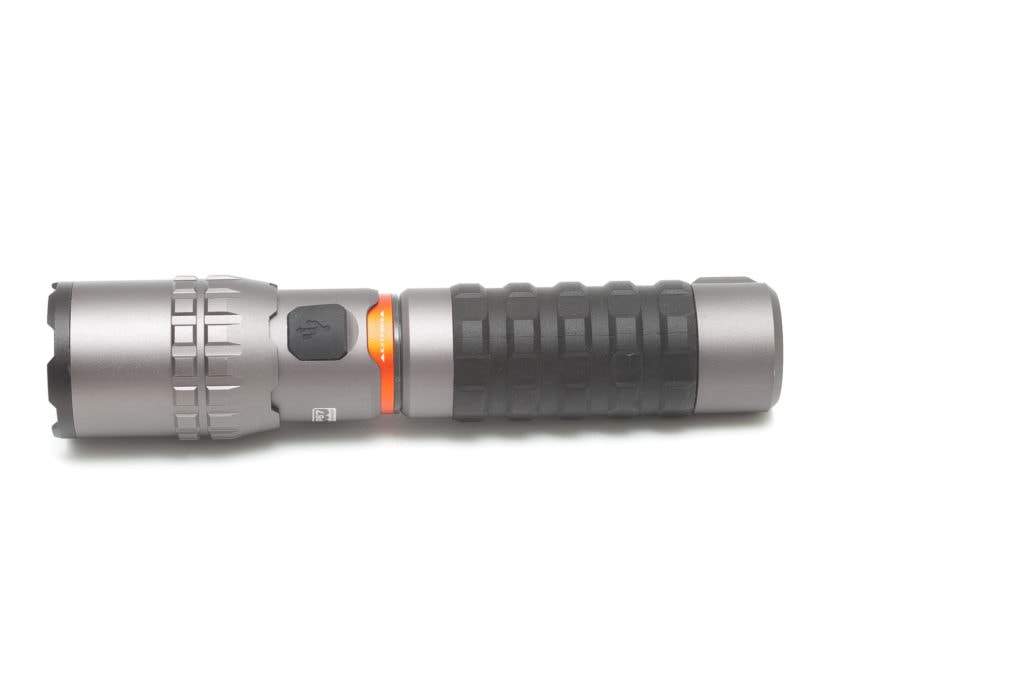
Nebo Slyde King 2K specifications
| Brand/model | Nebo Slyde King 2K |
|---|---|
| LED | N/A |
| Max. Lumens | 2,000 lm |
| Max. Beam intensity / distance | 409 meters (about 42,000 cd) |
| Battery config. | 1*18650 (proprietary) |
| Onboard charging | USB-C |
| Modes | 2+2+ramping |
| Blinkies | Red flashing |
| Reflector | Zoomy + COB |
| Waterproof | IP67 |
| Review date | April 2022 |
Introduction:
Nebo is a major flashlight company with many flashlight in their line-up. And we’re happy to be able to test some of their products, including the Slyde King 2K. The specs mention quite a few features, including a ‘hidden’ COB light, magnetic tailcap, focusable beam, USB-C rechargeable, IPX7 waterproof, and 2000 lumens. And it’s advertised as a work light, so no EDC, Tactical or such.
Having 2,000 lumens is not bad, since that’s brighter than about 95% of all the flashlight currently on planet earth.
Since I don’t have any experience with Nebo’s lights, I’m curious to see if they can increase the heartbeat of a long-time flashlight user like myself.
So let’s dive in.
Package quality.
The packaging seems to be adequate, yet not very sophisticated. It’s a simple cardboard box with a few accessories and a manual. There’s plastic covering the whole package, so you need to remove that before you can open the box itself. This is what’s inside the box:
- The flashlight: Nebo Slyde King 2K
- Proprietary 18650 battery (loaded in the flashlight)
- Adjustable lanyard
- USB-C cable
- Manual
Here’s also a Nebo unboxing video I made:
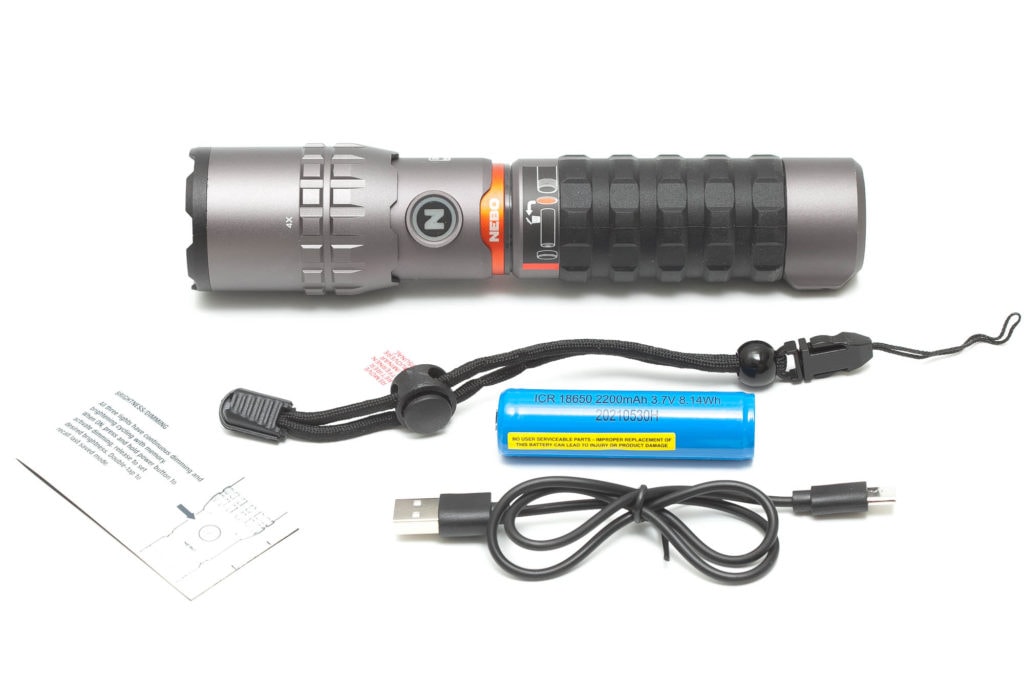
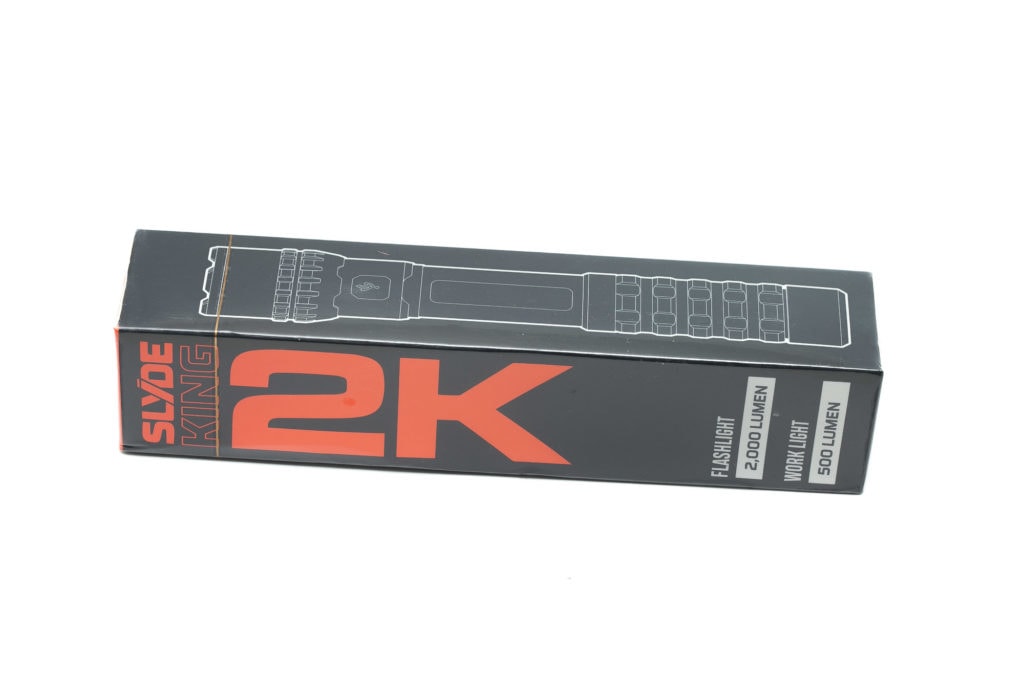
Flashlight in use
Before you can use this torch (to keep it British English), you’d have to take out the plastic insulation disc, inside the flashlight, by removing the battery first.
The Slyde King doesn’t look, nor feel, like the average flashlight that we, flashaholics are used to. The body is covered with rubber that feels quite nice, and grippy. It won’t slip out of your hand, even with hand gloves on, or with very cold fingers.
It doesn’t mean that I want to see this in every light.. actually not. But I can totally understand this on a work light like the 2K is advertised as.
The Slyde King has 2 light sources, namely a single LED at the front (with a focusable lens) and a COB hidden inside the batterytube. To see, and activate the COB light, you simply pull the battery tube while holding onto the head with your other hand. Once you start pulling, the COB light will turn on. I’m not 100% sure that’s the best way to do this, because it will turn on even when the COB light is only like 5% visible. But Nebo probably has a reason for this.
Some zoomy flashlights are push pull, but since that will activate the COB light, you need to twist the head to focus the main LED.
The switch is shrouded and lit when the light is turned on, and the color indicates the battery level. The following colors are available:
- Orange: 25%+
- Orange flash: less than 25%
- Green: fully charged
- Green pulse: charging (we usually call this breathing)
It would have been nice to have some more battery level indicators. Having only 1 indicator for 100% to 25% is not very handy. I’d rather have more battery levels, like 100-75% 75-50% 50-25% 25-10% 10-5% <5%
That way, it’s much clearer what the battery life is, and when you need to recharge.
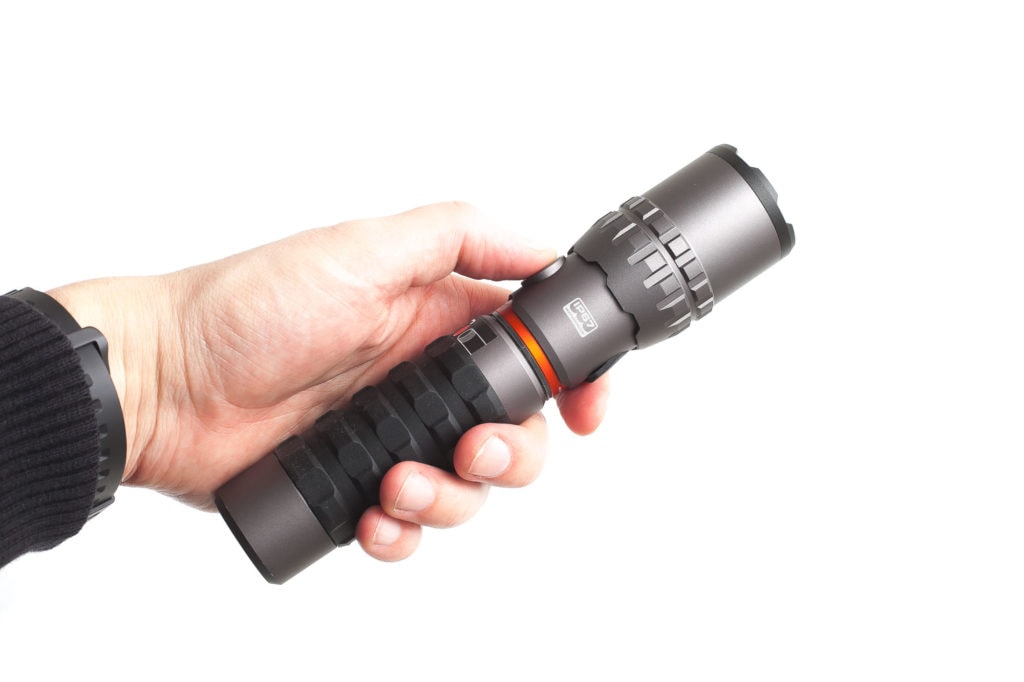
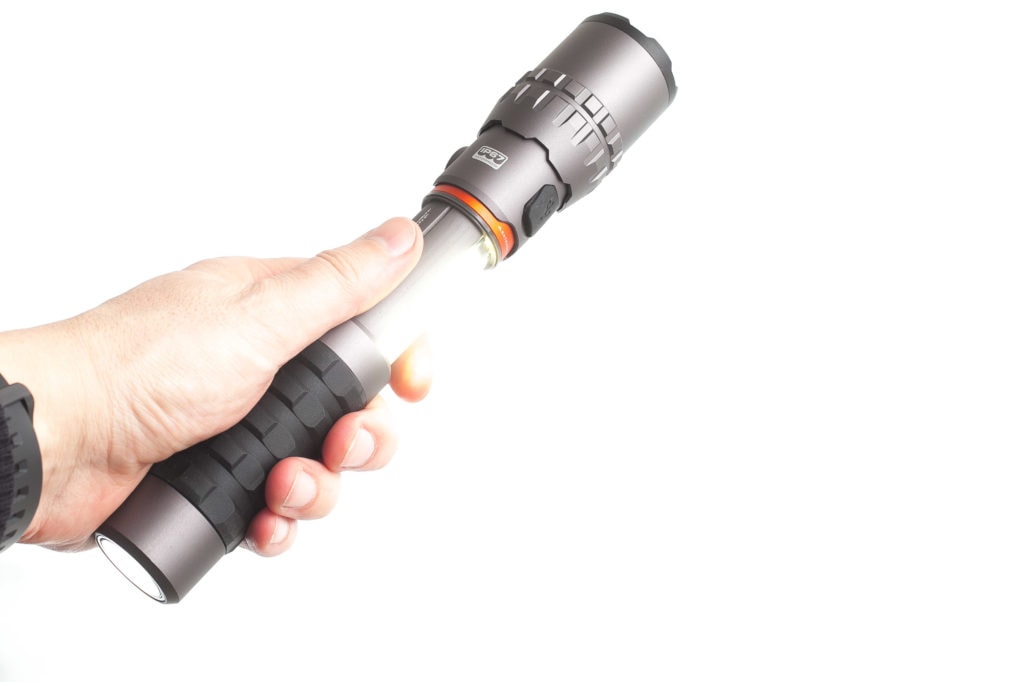
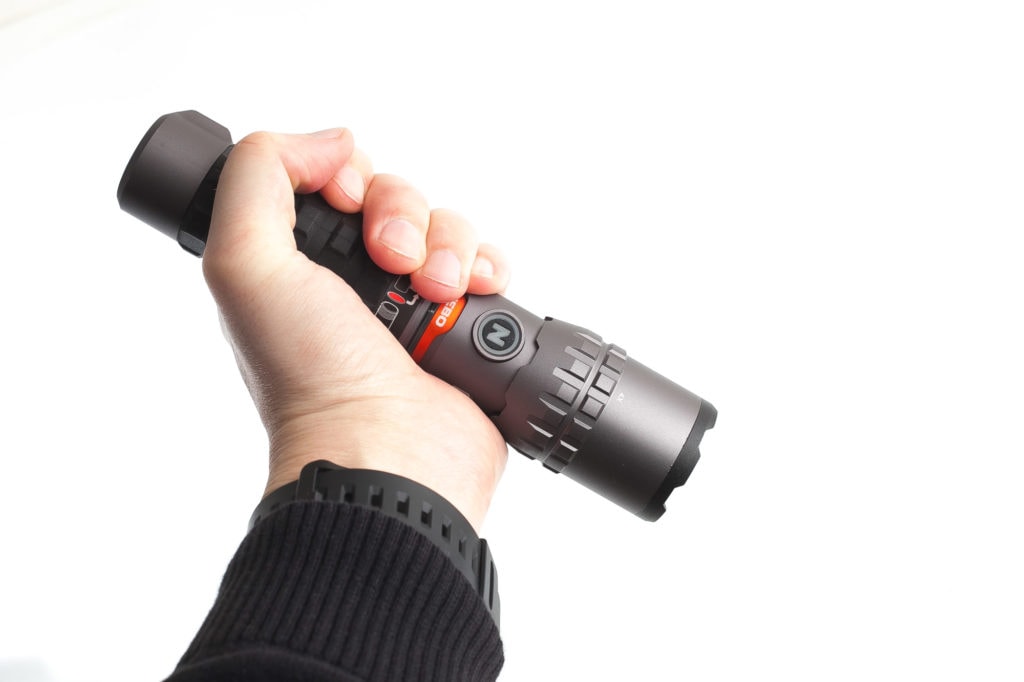
Build Quality, and Warranty
The Slyde King 2K feels pretty good in the hand and its build quality is definitely good.
The head has little to no wobbling at both ends of the zoom, but it does have some wobble halfway through it. This is nothing to worry about unless you are using it in a very wet environment because it would indicate a larger gap.
Because of the rubber grip, there is no need for knurling on the battery tube itself, but the head does have some in order to twist it for the zooming function.
Nebo used a very strong magnet in the tailcap. This is probably the strongest magnet I have ever found on any flashlight. So that’s a good sign, especially when you consider this to be a work light. I was talking about the main tailcap, because it has 2 tailcaps. Underneath the main tailcap with magnet sits another tailcap that will give you access to the battery. This one has some traditional knurling and is only accessible when the COB light is turned off.
There were a few very small spots on the anodization in some tiny machining marks around the light, but nothing to worry about, if you are going to use it as a work light. It’s not meant to be a shelf queen, and will also never be one.
In terms of warranty, Nebo gives a 2-year warranty.
This is what the Nebo UK website mentions:
“If the NEBO product is found to be defective during the warranty period it will be replaced free of charge. Should the product be discontinued it will be replaced with an item of equal value. The warranty does not cover: water damage, improper handling, battery life, bulbs, colour clarity, colour finish, accidents or wear and tear. Proof of purchase is required for all claims.”
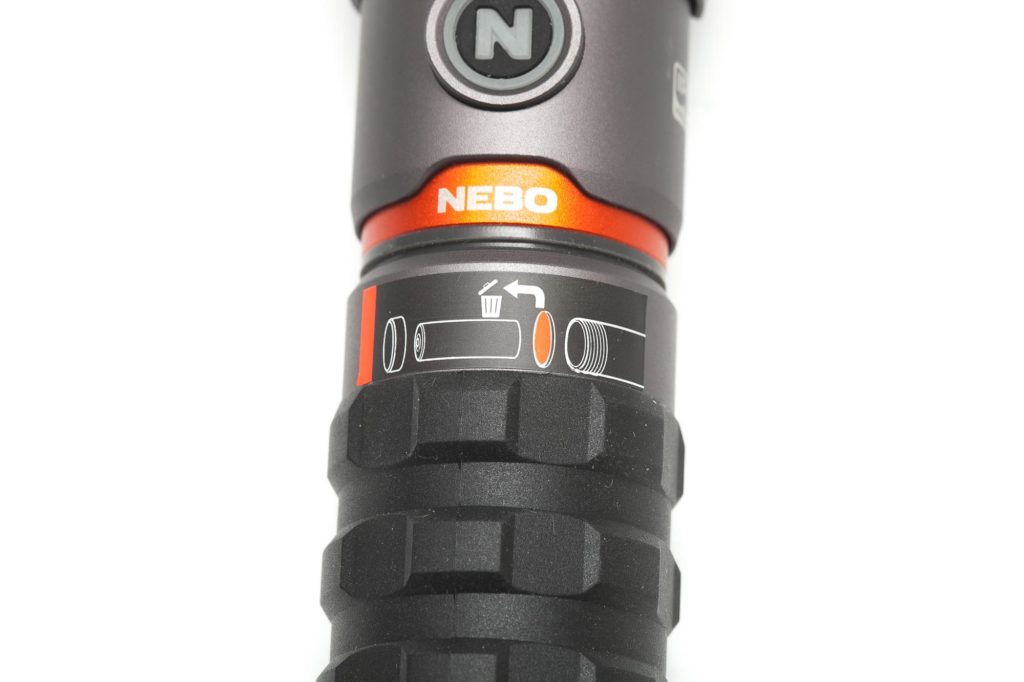
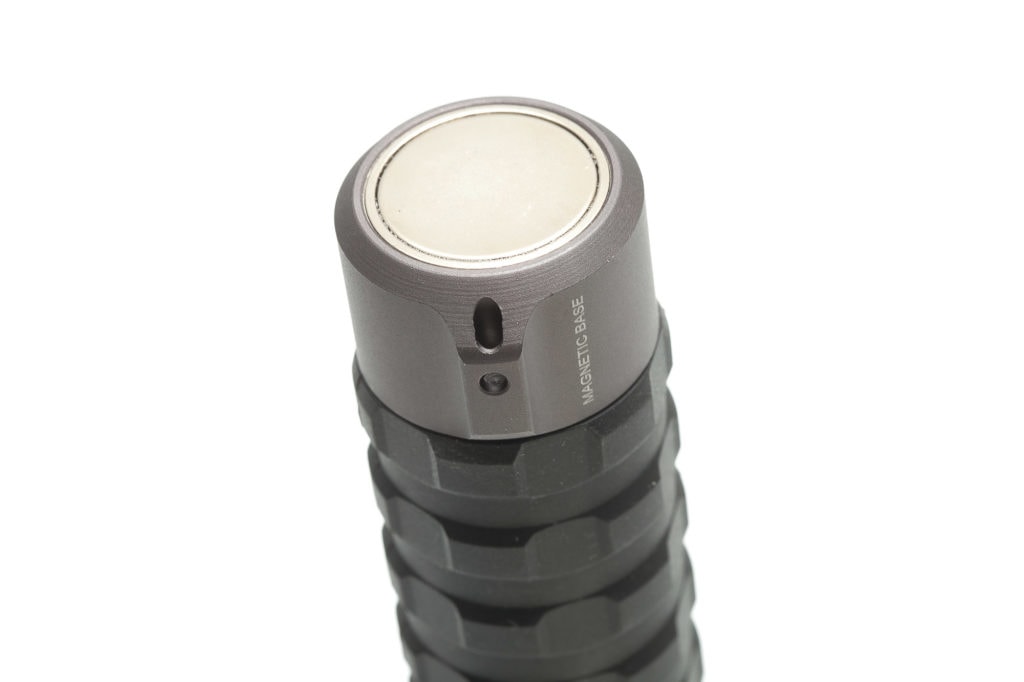
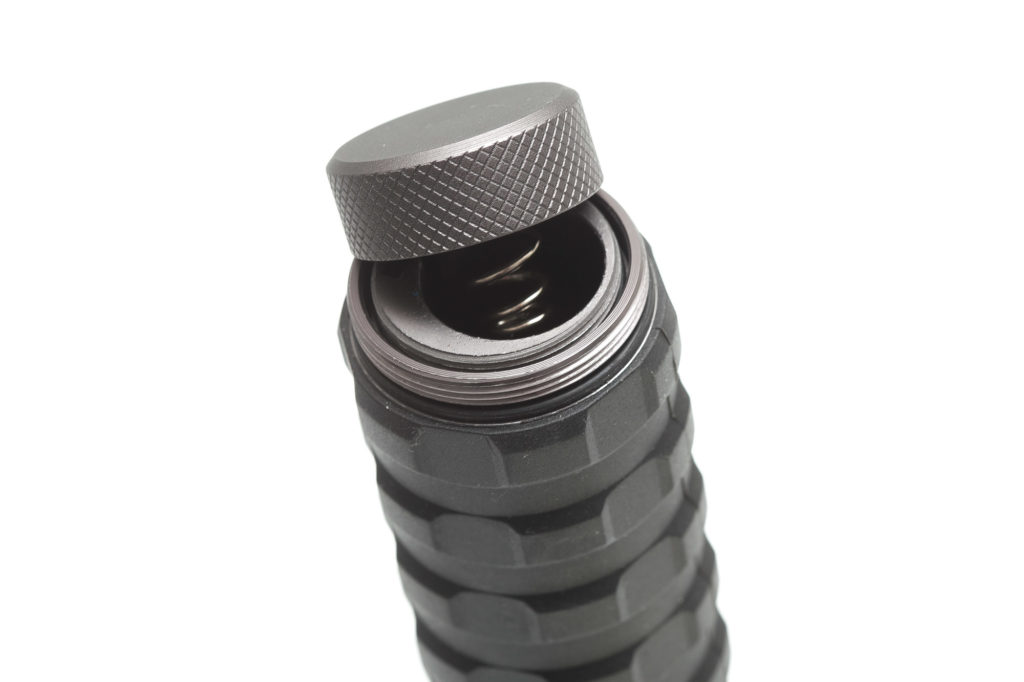
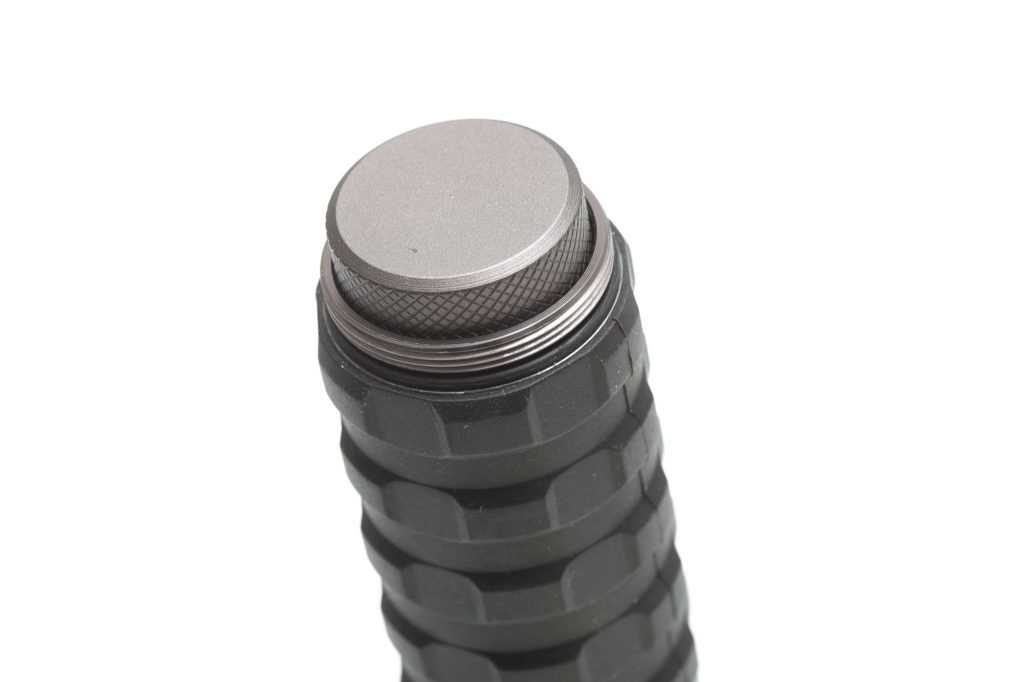
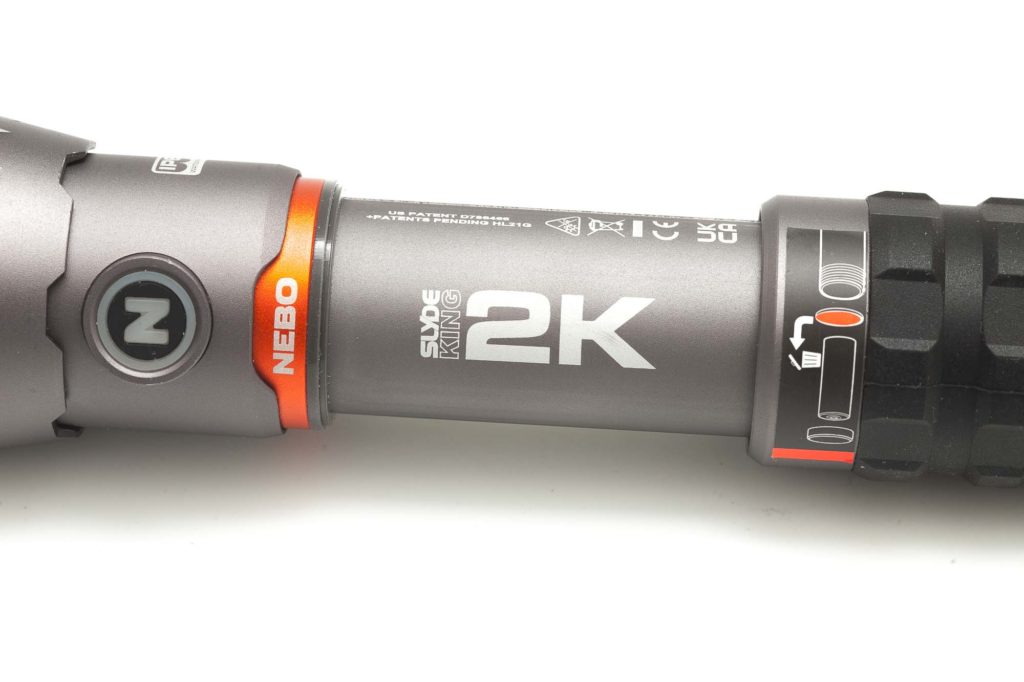
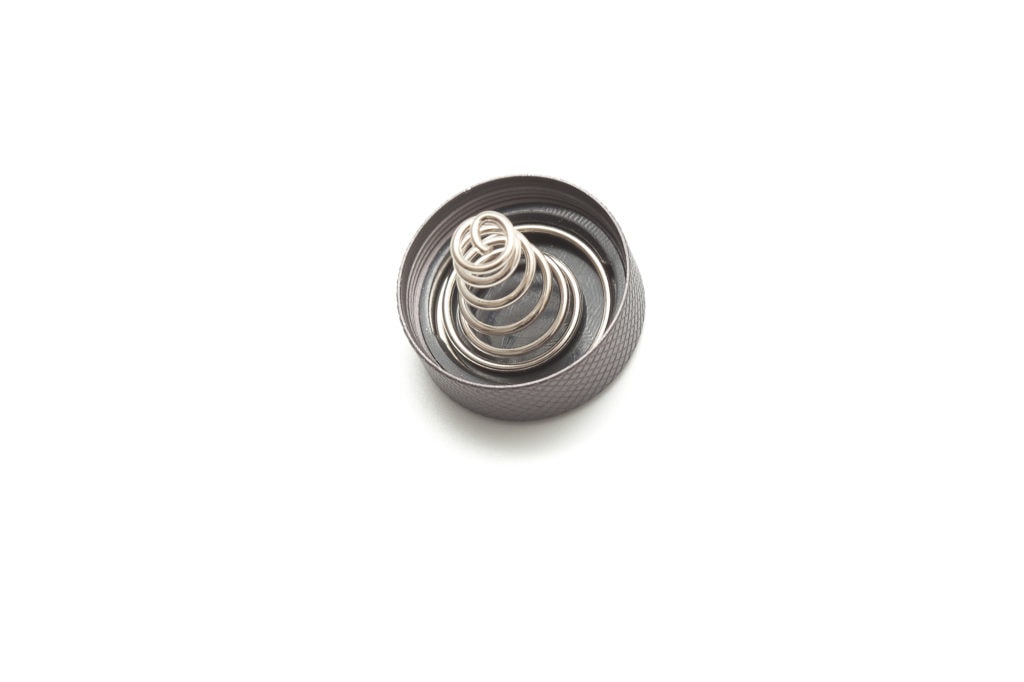
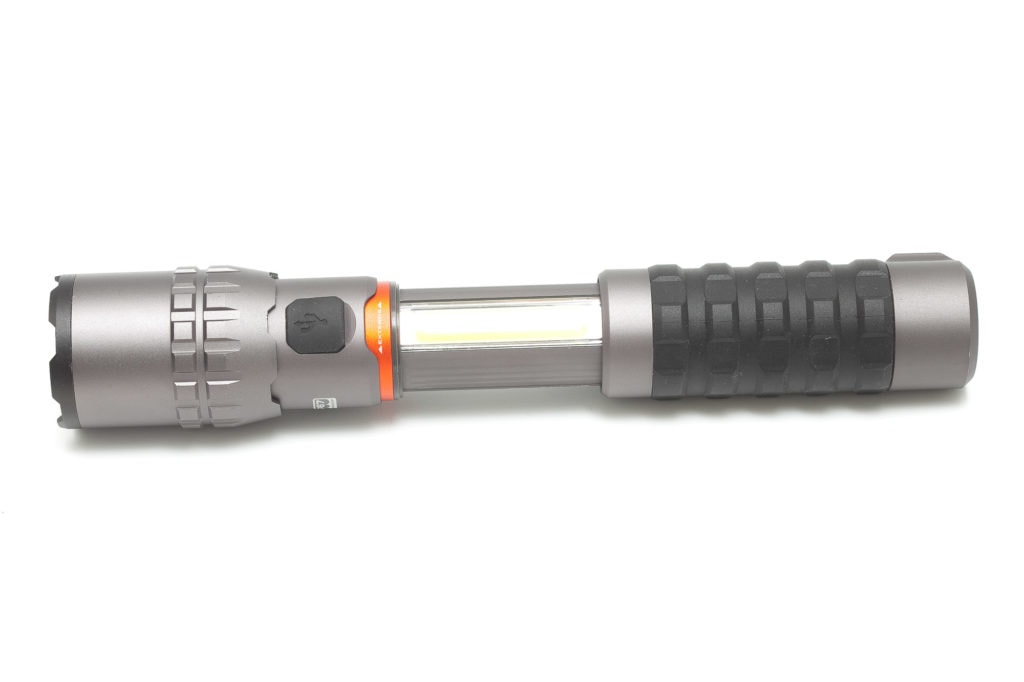
LED, Lens, Bezel, Beam, and Reflector
Nebo doesn’t mention anything about the brand of LED that is used. From the front, the LED is clearly visible, but I’m also not sure what brand and type it is. It’s an LED with 4 dies in 1. It sits behind a (plano) convex lens in the middle of a white centering ring. The LED isn’t perfectly centered, but that’s probably not a big problem.
Like with many zoomies, the convex lens is not protected by a flat glass lens. That would have been preferred because a convex is more likely to damage and more difficult to replace than a simple glass lens.
There’s a black crenulated bezel that protects the lens when dropping the light. It’s not glued, so you can remove it by hand and get access to the internal, so that’s great for modders.
Zoomed out (with the widest beam) the beam is quite uniform in the center all the way up to the edges. There’s a yellowish ring visible on the outside of the beam, just like you’d expect from a focusable flashlight.
When the light is zoomed in (narrow spotlight) the beam becomes square-ish with rounded corners. At a close distance (1-2meters), you still see a weak ring outside the hotspot. That ring will become invisible after about 5 or 10 meters.
With the Opple Light Master III I measured the following while zoomed in (tightest spot):
- CCT: 10104K (which is very cold white)
- Ra (CRI): 74.4
It’s interesting to note that the CCT is supposed to be 10000K and extremely cold, but in person it’s not really blueish.
I also measured it between 20-30% from the outer ring of the beam, and it dropped to 7000K. The yellowish ring on the outside of the beam is about 4500K.
I also tested it with the flashlight zoomed out (widest beam), and got the following numbers:
- CCT: 7779K
- Ra (CRI): 73.0
This is not as cold as the spot measurement, but still very, very cold.
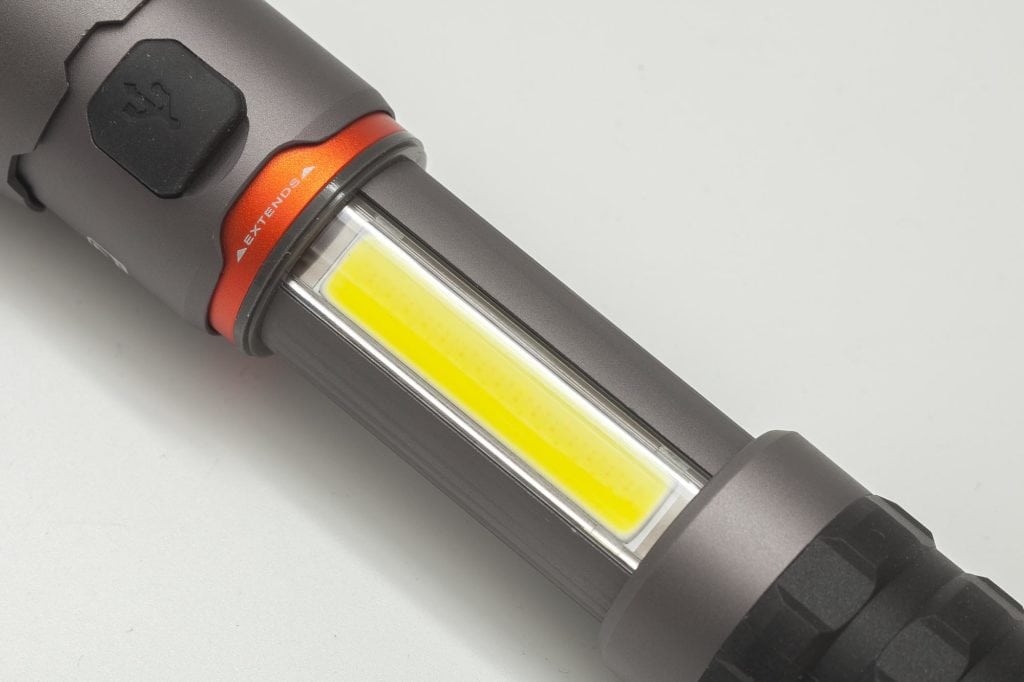
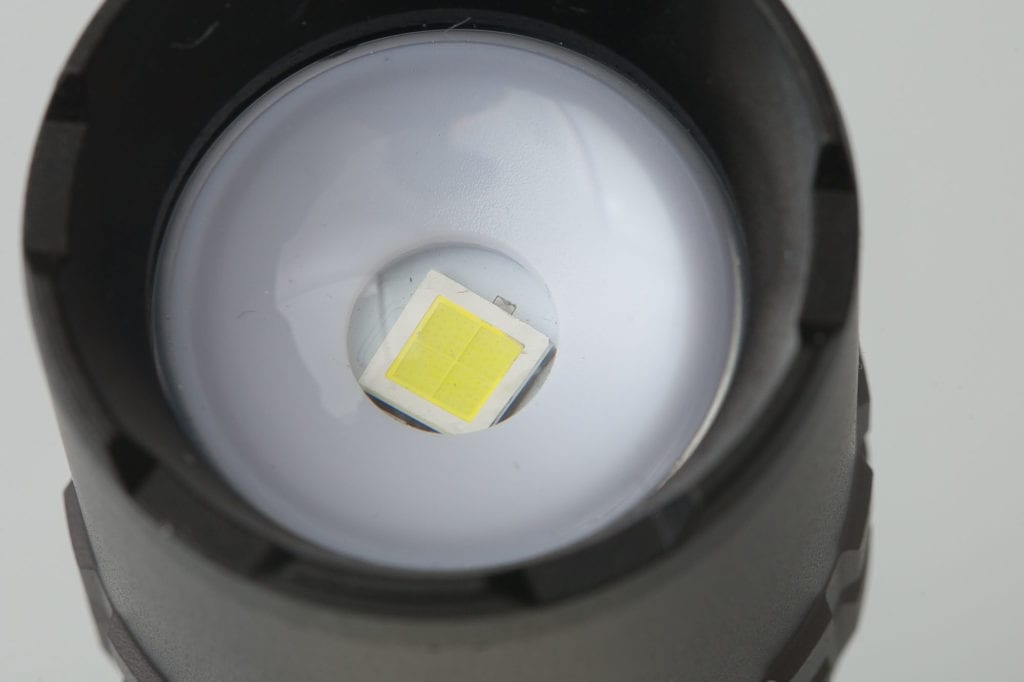
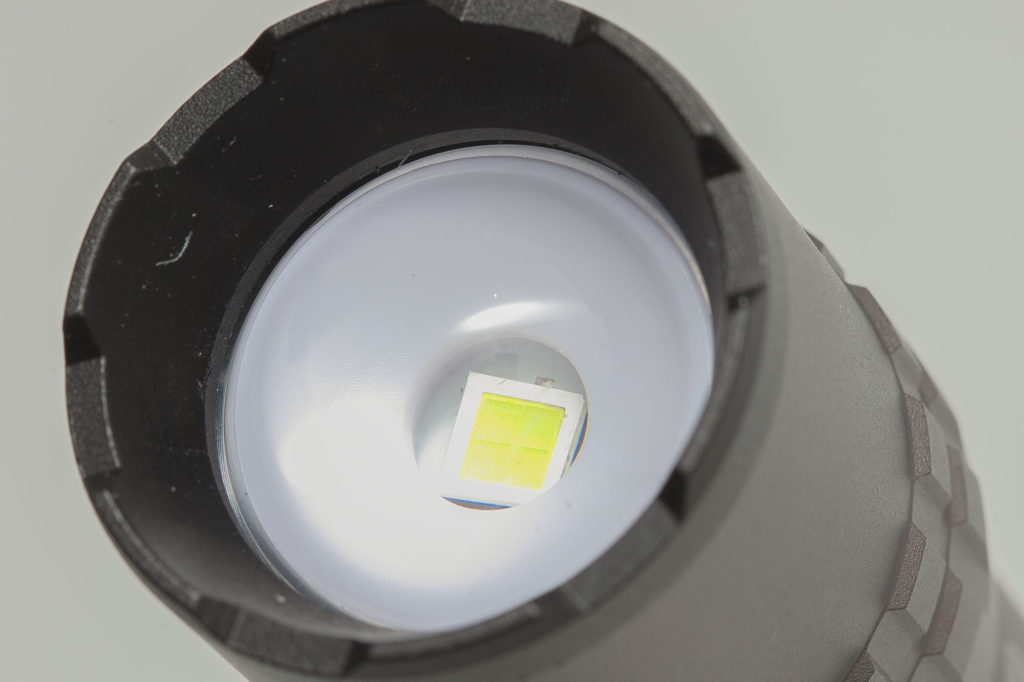
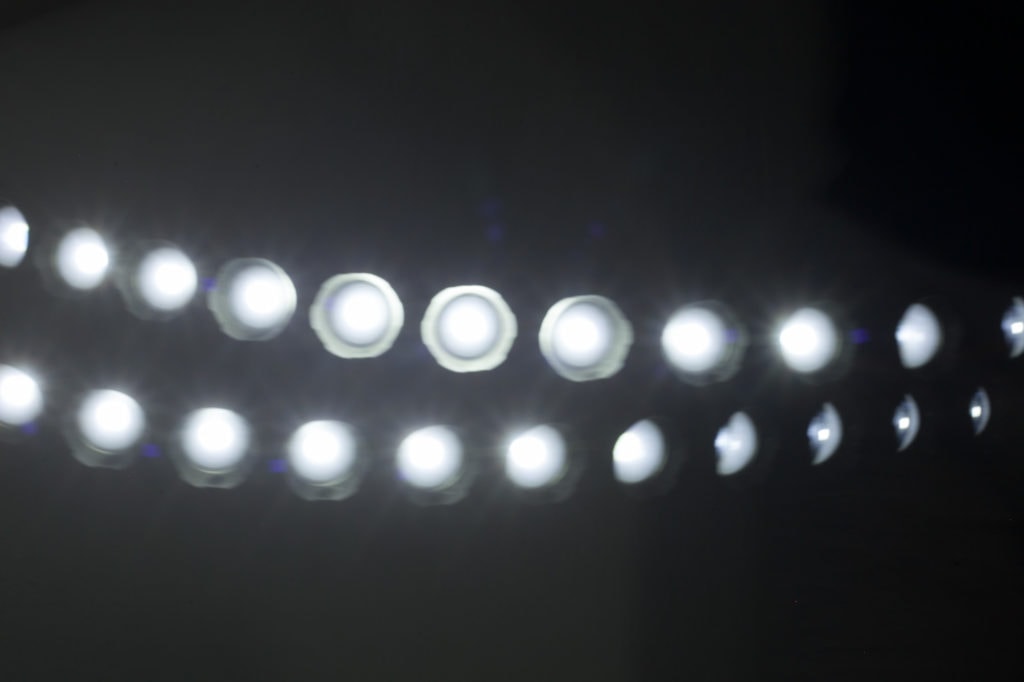
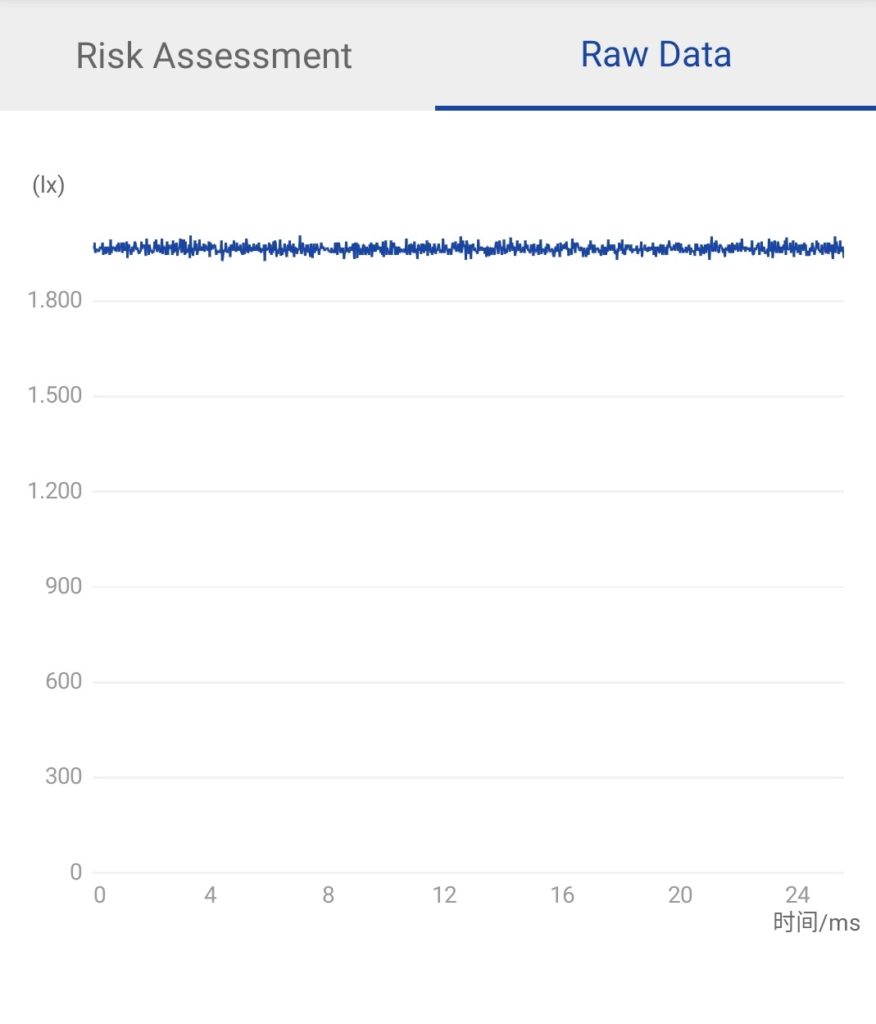
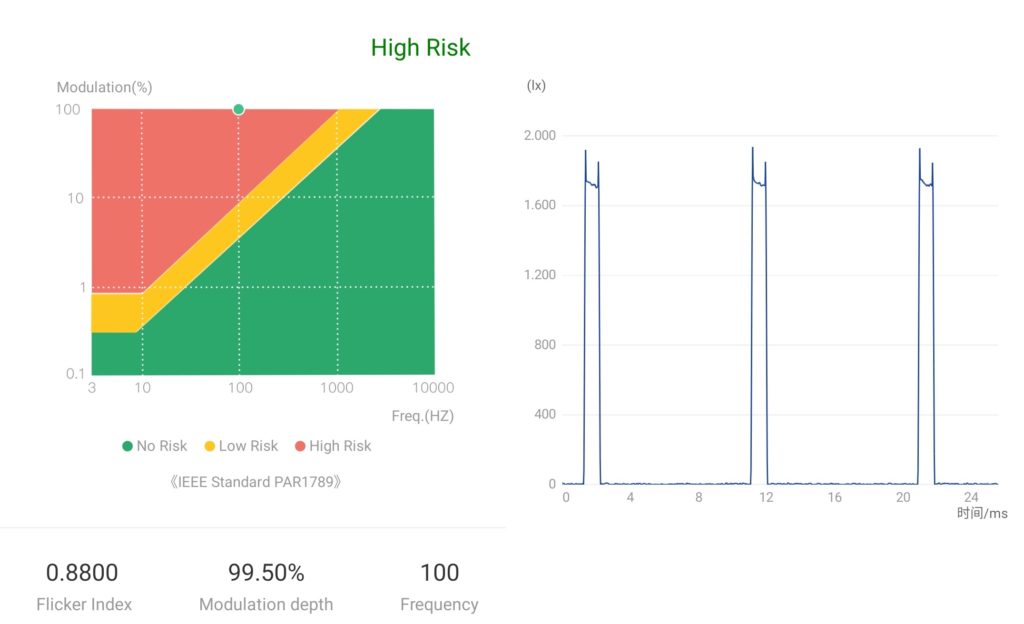
Dimensions and size comparison
- Length: 190 mm / 7.48 ”
- Length zoomed: 209 mm / 8.228 “
- Length zoomed + COB exposed: 261 mm / 10.275″
- Head diameter: 41.5 mm / 1.63 ”
Weight:
- Empty: 334.8 g / 11.81 oz
- With battery: 383.1 g / 13.51 oz
Flashlight comparison
Size compared to other Nebo flashlights: Nebo Galileo 1000, Nebo Slyde King 2K, Nebo 12K, Nebo Luxtreme SL100
Image 2, from left to right: Nebo Slyde King 2K, Nealsgadgets 26650 LEP, Olight Warrior 3, Convoy S2+
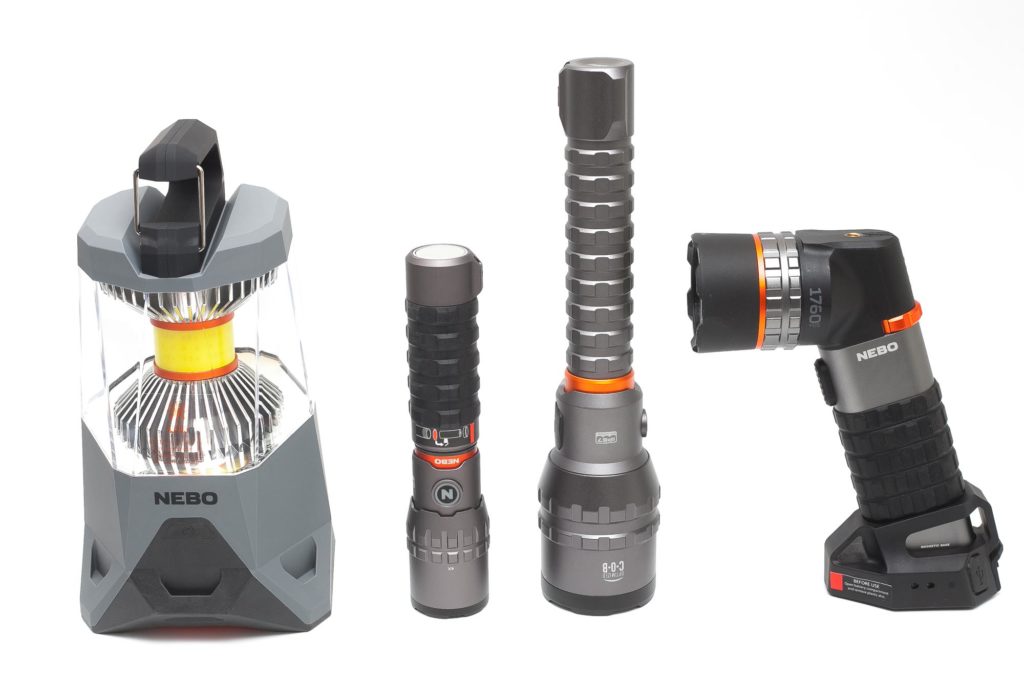
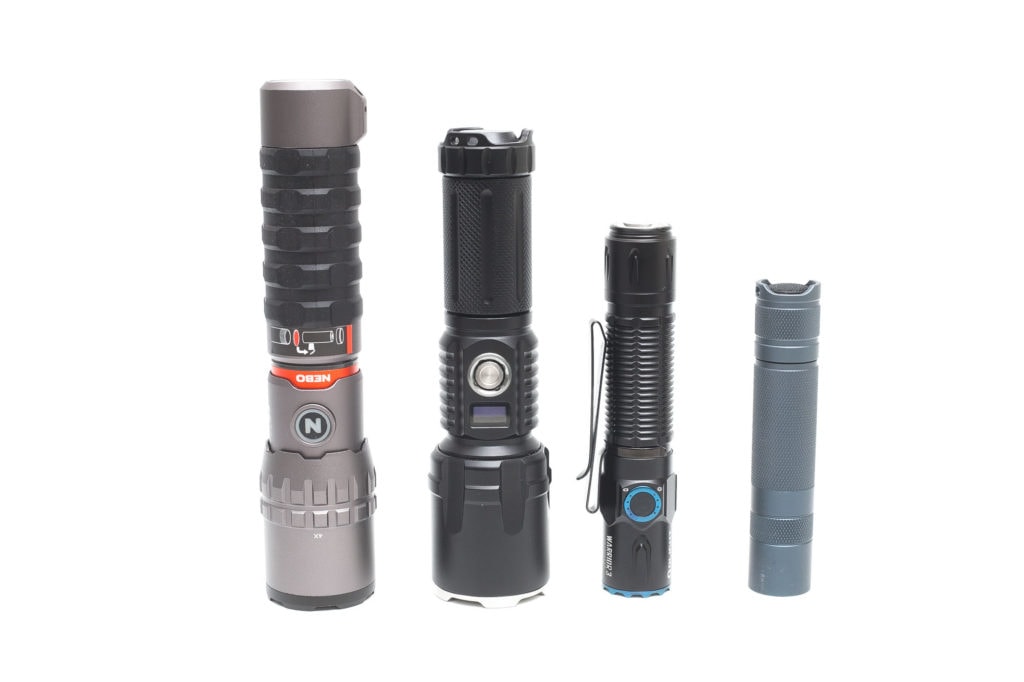
Driver & User Interface:
The user interface on this light is very easy to understand. But there are a few things that you wouldn’t know unless you read the manual.. but since real men don’t read manuals, better pay attention now.
The main LED has a ramping configuration with memory mode. The memorized output is only available by a double click.
Available modes normal light (front):
- Ramping
From OFF:
- Single-click: Highest output
- Double click: Memorized output mode
- Triple-click: nothing, it just turns off again
- Press and hold: nothing
From ON:
- Single-click: Off
- Double click: nothing. It’s funny to see 1 click, 3+ clicks turning the light off, but 2 clicks doing nothing
- Triple-click: light just turns off
- Press and hold: ramping brightness up and down. It will blink at the highest and lowest output, but if you keep pressing the switch, it just continues ramping up and down
Available modes COB light (side):
To activate the COB light, simply pull the head from the body. The COB light will turn on directly when you start pulling, even with only 3 millimeters moved. That means that the light will be turned on, while covered for 95% by the flashlight body.
By default, it turns on in the White mode. But if you press the side switch, and slide the body, you can get red light directly.
When the COB is on, you can also use the side switch to switch between White, Red, and blinking RED
Shortcuts:
- To High: single click from Off
- To Low: double click if you memorized it
- To Red COB: press and hold the switch, while sliding the body to uncover the COB light
Mode memory:
- Yes, just ramp the brightness to any output, release the switch, and turn the flashlight off. That output will be the memorized output. Double click to return to the previous output. This can be anywhere between the highest and lowest output.
Blinky modes menu:
- The front light source doesn’t have any, but the COB light has a red blinking mode. Simply slide the body, and use 2 clicks to enter the blinky mode.
Low battery warning:
- It will turn off, and then blink…
Lock-out mode:
- None
PWM:
- Yes, very visible in anything except the highest output
Firmware / UI Conclusion:
The UI is straightforward, except for the double click for memorized output, and the shortcut to Red COB light.
Batteries & Charging
Nebo included a proprietary ICR 18650 lithium-ion battery, with a total capacity of 2200mAh. This is actually quite small for a battery nowadays. I don’t know why they couldn’t choose a 3000mAh or just use a 3500mAh battery. Since the light shouldn’t be pulling many Amps, a 3500 mAh battery would have been fine.
The battery has a negative and positive contact on the negative side. This means that you can’t use any other battery in this flashlight.
Charging is done with a USB-C cable (a USB A to USB-C cable is included), and it finishes charging at a safe 4.16V. The highest current I could see was 0.7A, which isn’t very high, and most of the charge time it was lower. I also tried to use a USB-C to USB-C cable on a charger, but that didn’t work. I then tried it with my desktop’s USB-C port, and that worked just fine. It looks like it doesn’t have any benefits using USB-C to USB-C over the traditional USB-A to USB-C. The charge currents remained the same.
Charging time is somewhere between 3 and 4 hours.
While charging, the switch is lit with a breathing green LED. When the charge has finished, the switch will be lit continuously.
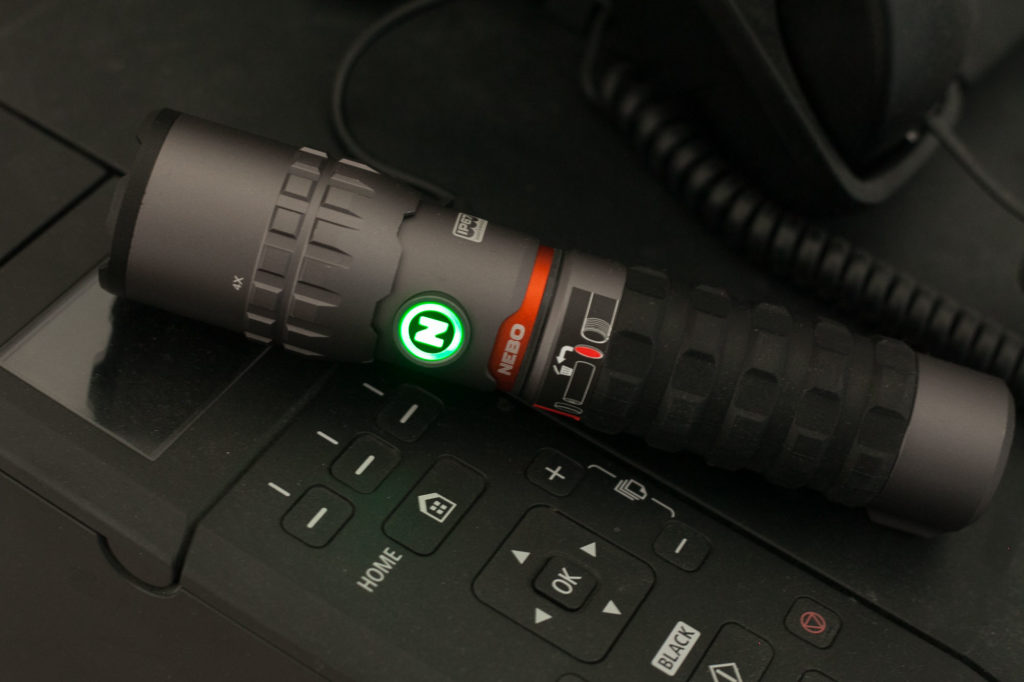
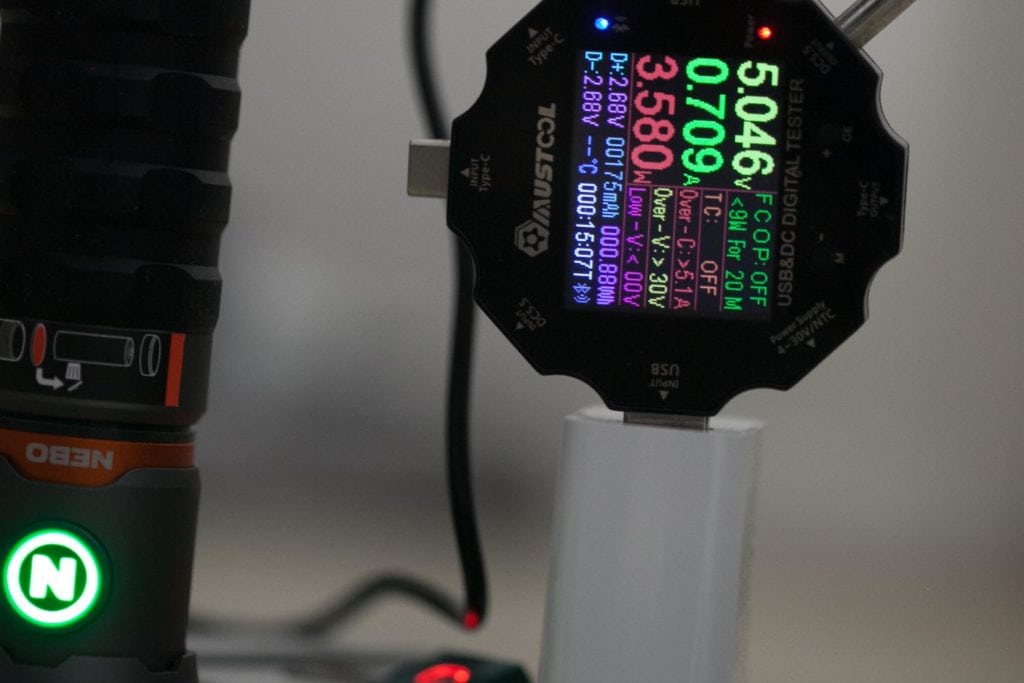
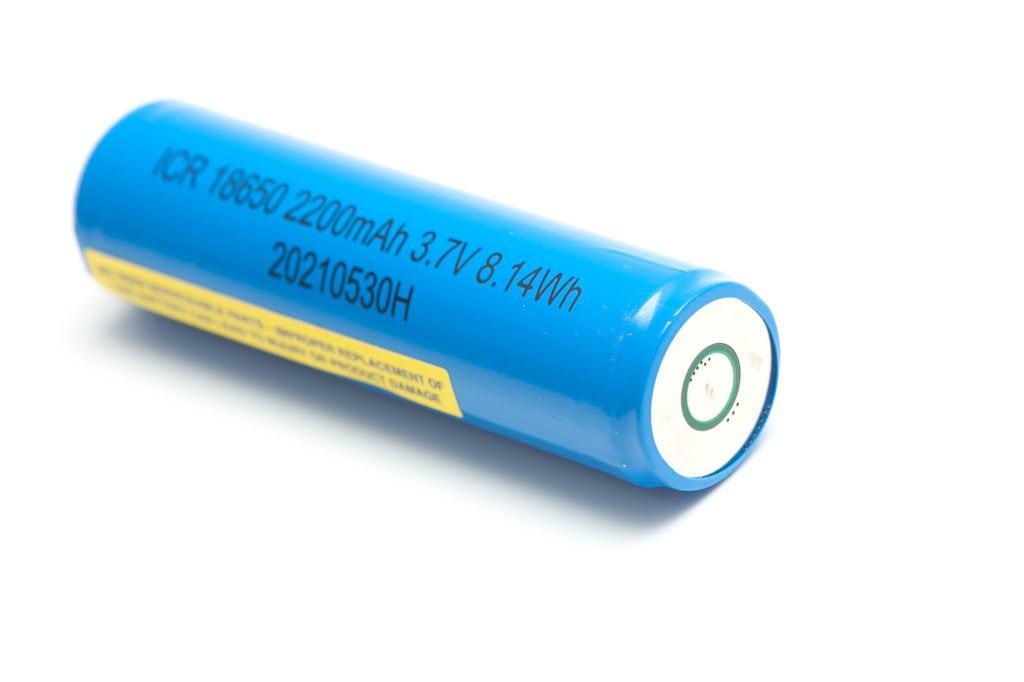

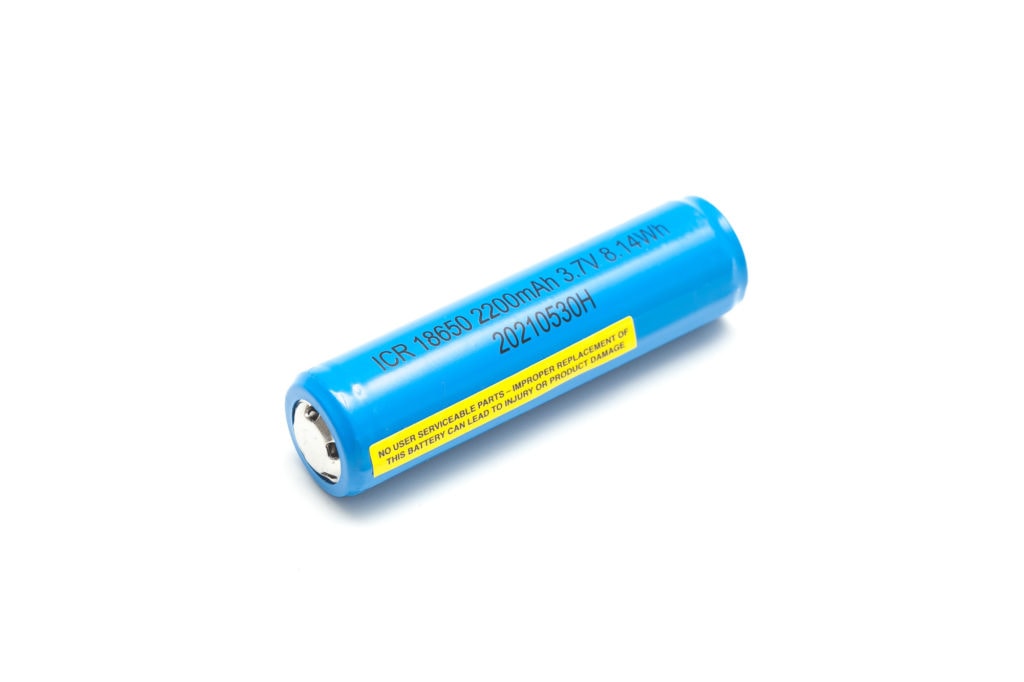
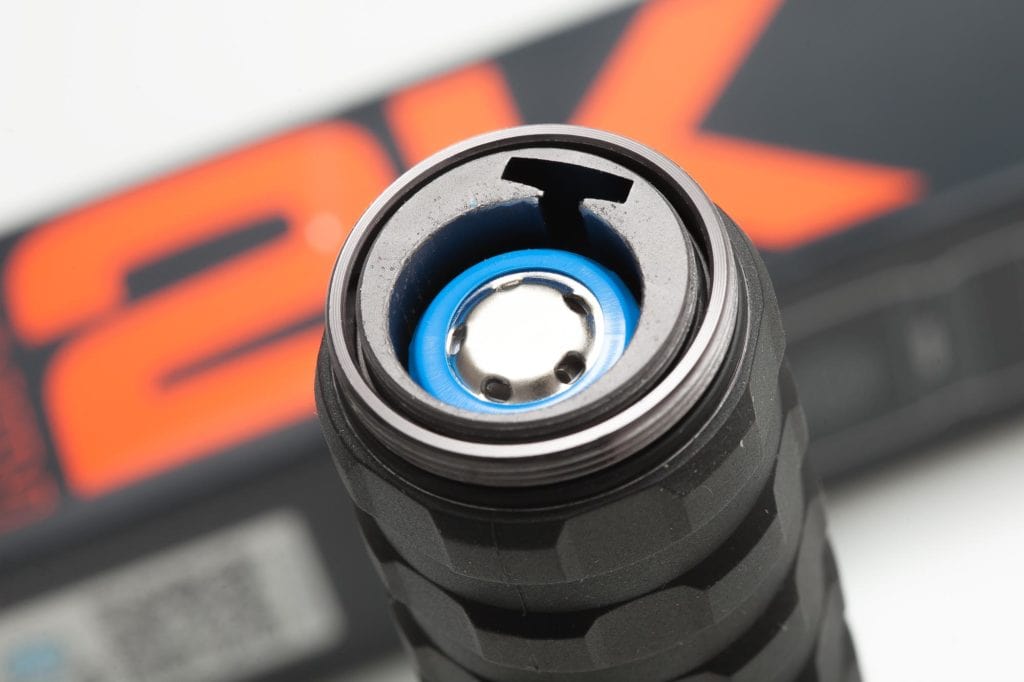
Performance test
Lumen measurements:
All output numbers are relative to my homemade Integrating Sphere. It is set up with an Extech SDL400 Lux Meter for measurements including a Kenko PRO1D ND-16 filter. The base measurement is done with a Convoy S2+ that has been tested at 255 lumens.
I used the included battery for the following measurements
| Mode | Specs | At turn on | 30 seconds | 10 minutes |
|---|---|---|---|---|
| Lowest | 200 | 191 lm | 148 lm | 67 lm |
| Lowest (zoomed in, spot) | 200 | 75 lm | 57 lm | – |
| High | 2,000 | 1951 lm | 1802 lm | 641 lm |
| High (zoomed in, spot) | 2,000 | 767 lm | 700 lm | – |
| COB | 500 | 627 lm | 581 lm | 271 lm |
Specs didn’t specify in what focus position those lumen numbers are measured, but we can assume that in the normal position with the widest beam.
The lowest output is 191 lumens, which is still quite a bit. A bit too high. But since it uses PWM, anything lower than that output would make the PWM unbearable. So I understand they capped it off at 200 (191) lumens.
I’d like to point out the weakness of normal zoomie flashlights, and that’s the loss of light when the beam is focused into the tightest spot. The focusing lens is far from the LED, and a lot of light from the LED will be lost because it bounces around.
If you calculate the loss of light, with the numbers above, you see that both the Highest output and Lowest output had a loss of 61%. This is a lot, but quite normal on focusable flashlights.
A very impressive way to reduce the loss of light is by using something like a Wavien Collar. This will ‘recycle’ the light, and the output loss is only about 10% (I measured 7.6% loss on the Microfire Excalibur H20, and 5.4% on the H8). But those are quite rare.
During the lumen test, I noticed that the Low mode drops a few lumens every few seconds. It’s not like it’s a smooth drop like you see with other lights, but short instant drops. I haven’t seen this behavior before, as far as I can remember.
Parasitic drain:
- Can’t measure this with the proprietary battery setup
Runtime test / battery life:
The runtime test was done with the 50cm integrating sphere, and Extech SDL400 data logging Lux Meter.


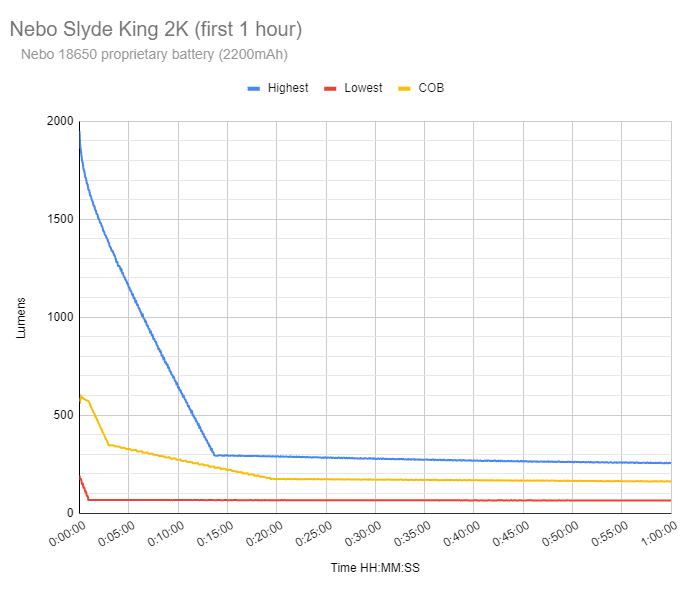
The Highest output doesn’t drop as fast as you’d think. It takes almost 15 minutes to drop from about 2000 lumens down to 295 lumens. Yes, that’s low. At 2h14min it reaches 180 lumens (which is considered the end of the runtime as per ANSI 1FL standards). But the light continues to drop output and finally turns off after 3h14min. Battery was down to 2.7V.
You can see that it takes 6.5 minutes to reach 1000 lumens…. which is actually a really good performance! And 11.5 minutes to reach 500 lumens. Most flashlights drop below 1000 lumens within 3 minutes…
The Lowest output starts at around 190 lumens, drops to 148 lumens in 30 seconds, and 66 lumens in 1 minute. It’s interesting to note that the light drops in steps, and not gradually. That’s kind of hard to tell in this graph, because the measurements are done every 5 seconds. You’d have to look at the 10 minutes graph to see this. The runtime is supposed to be 10% of the initial 30 seconds reading, so that means about 6.6 lumens. That’s about 16 hours. At 17h06min the light finally turns off.
COB: Starts at around 627 lumens, and after 30 seconds 581 lumens, and 565 lumens at 60 seconds. Runtime (10% of 581 lumens) is at 7h01min and turns off at 7h28min.
Throw Measurement
Measurements were taken indoors at 5 meters with a Hagner E4-X Lux Meter. Measurements were recorded after 30 seconds, as per ANSI FL1 standards.
| Mode | Specs | I Measured | Meters | Yards |
|---|---|---|---|---|
| Highest (spot) | 409m (41,900 cd) | 37,550 cd | 388m | 424 yd |
| Highest (widest) | – | 1,775 cd | 84m | 92 yd |
| Lowest (spot) | 125m (3,900cd) | 2,850 cd | 107m | 117 yd |
The measurements in the highest output mode weren’t too far off, but the lowest mode wasn’t close in terms of candelas. But when you just focus on the distance: 125 meters vs 107 meters, that doesn’t seem to be a big difference.
The lowest mode starts dropping several lux every few seconds, so I recorded the lux numbers at about 30 seconds.. which may just before or after such drop.
Beamshots
For the following beamshots, I used a Canon EOS 5D Mk2 and a 50mm lens. manual settings: ISO1600, 1/4sec , F4, 5000K
The shed is about 65 meters / 71 yards away.

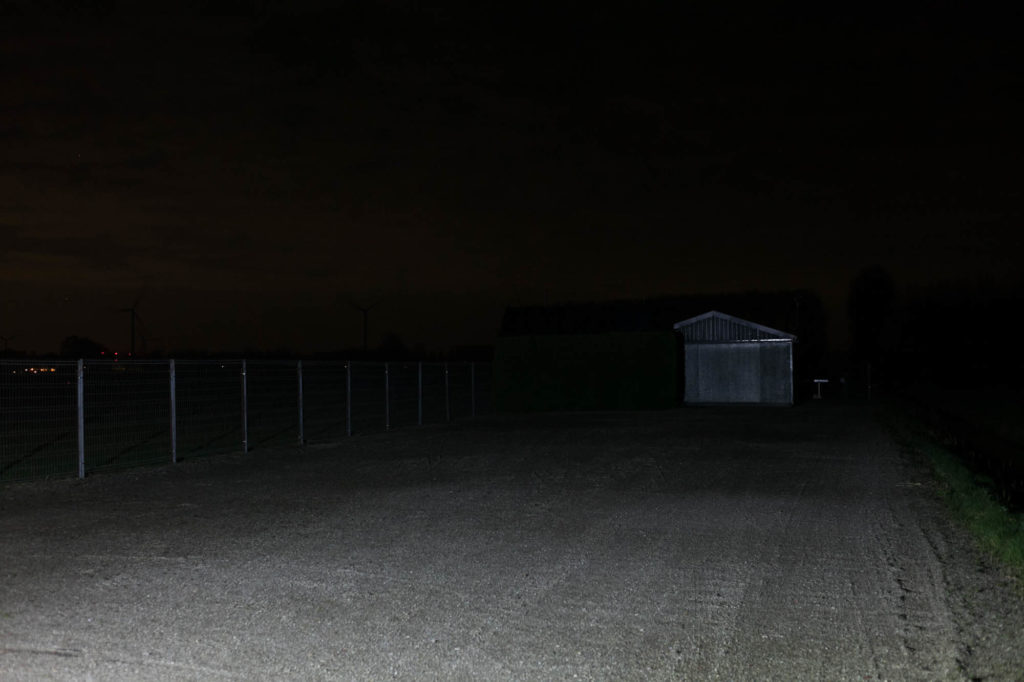
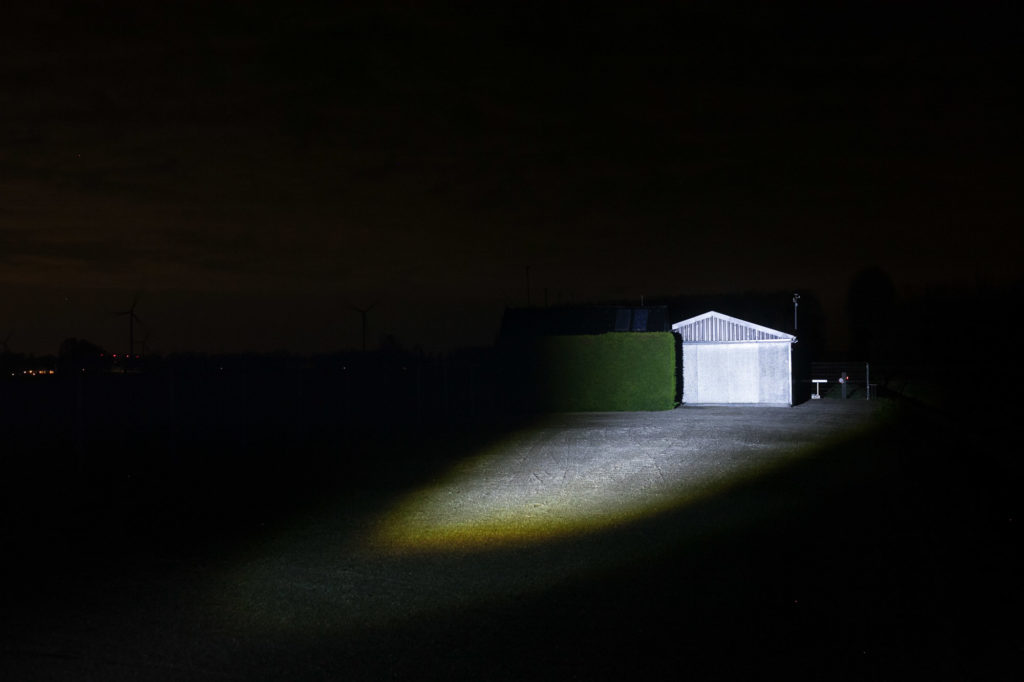
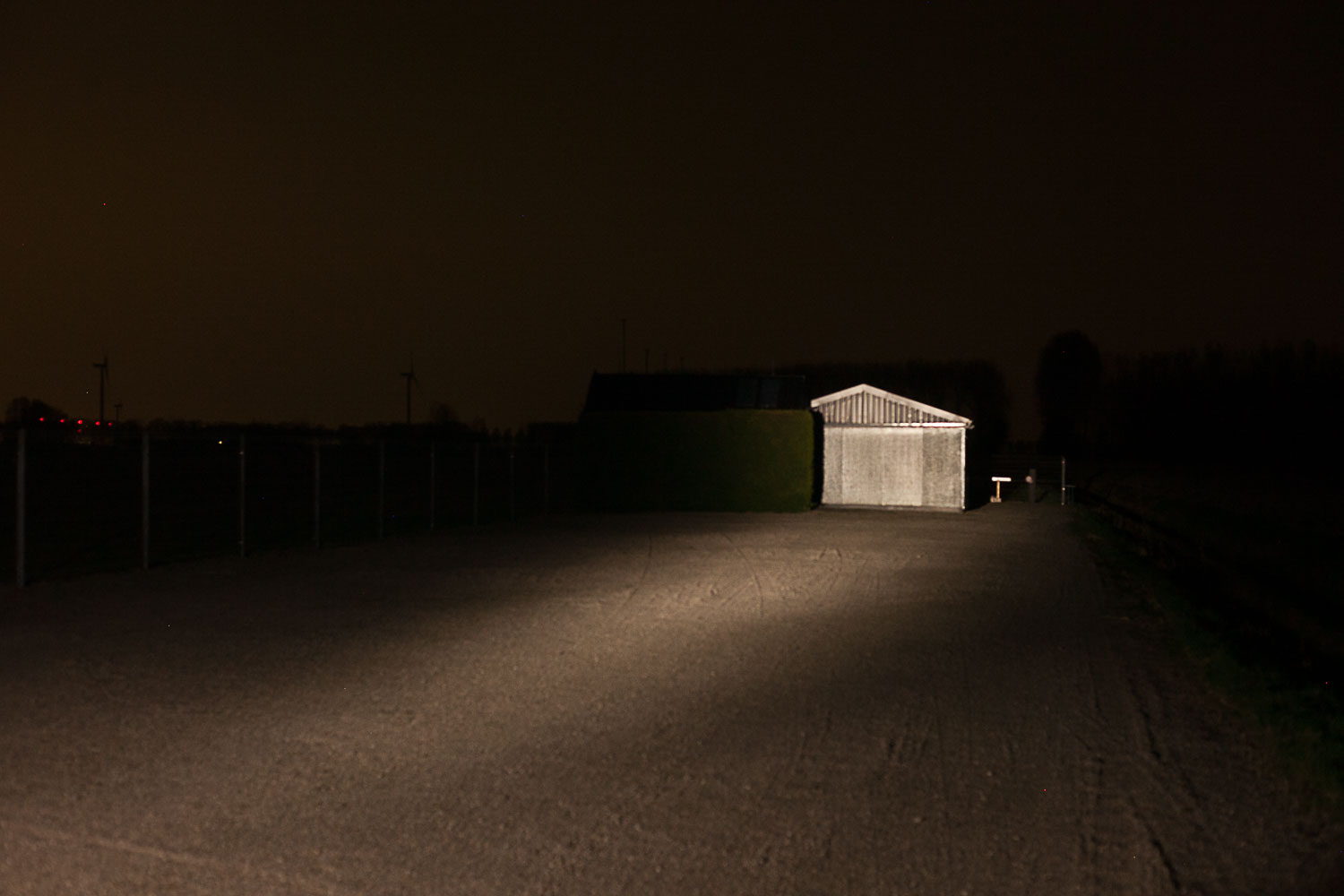
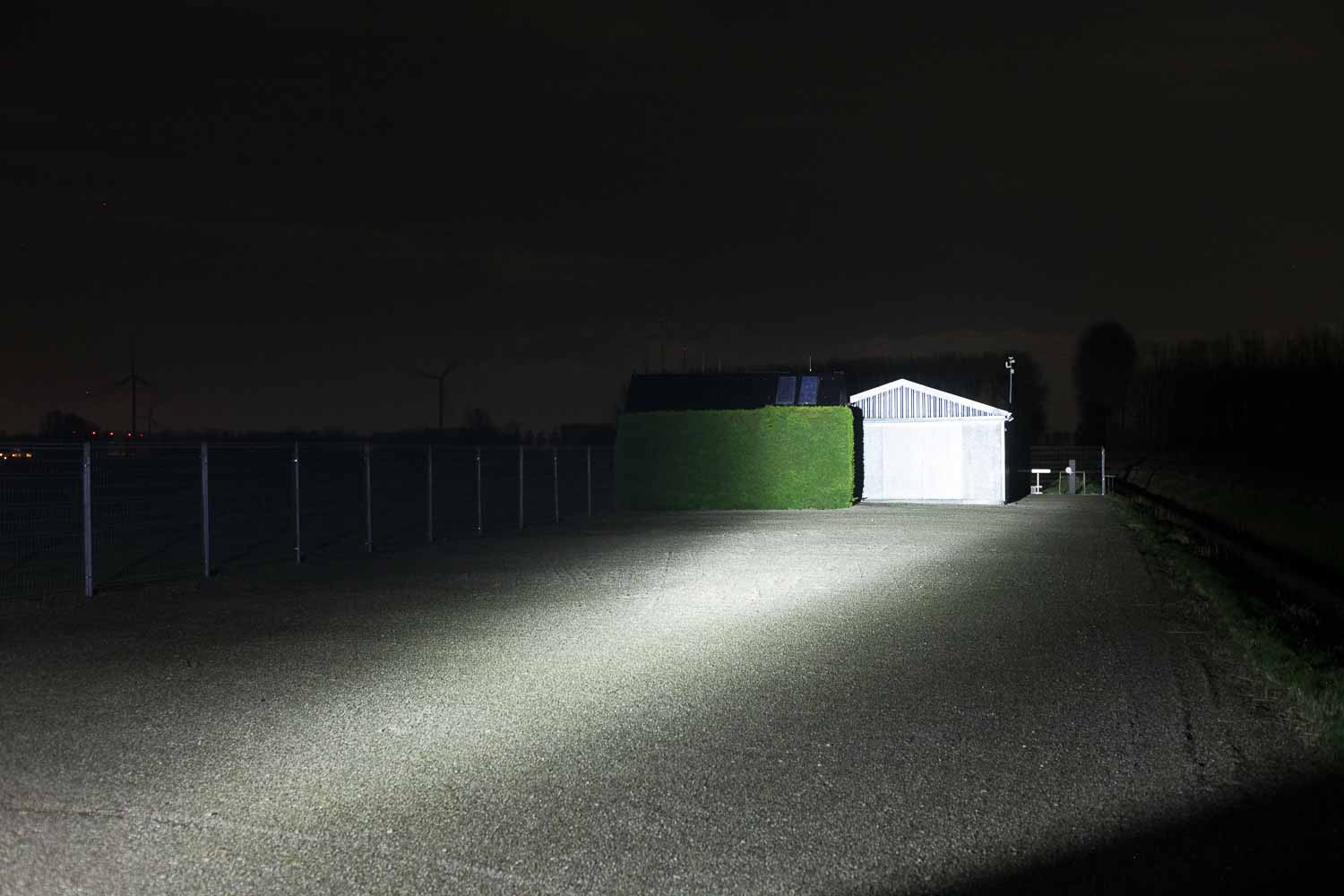
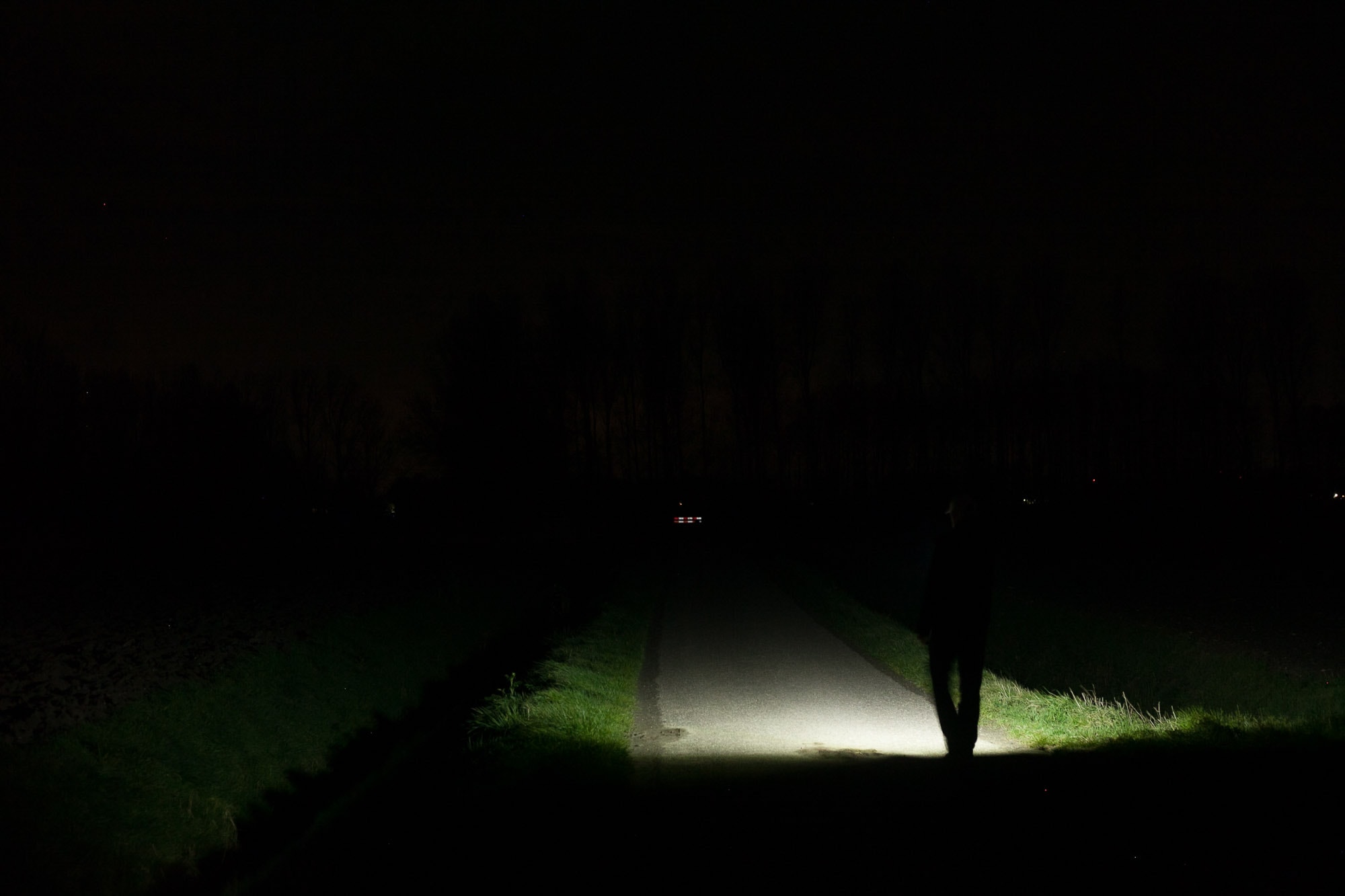
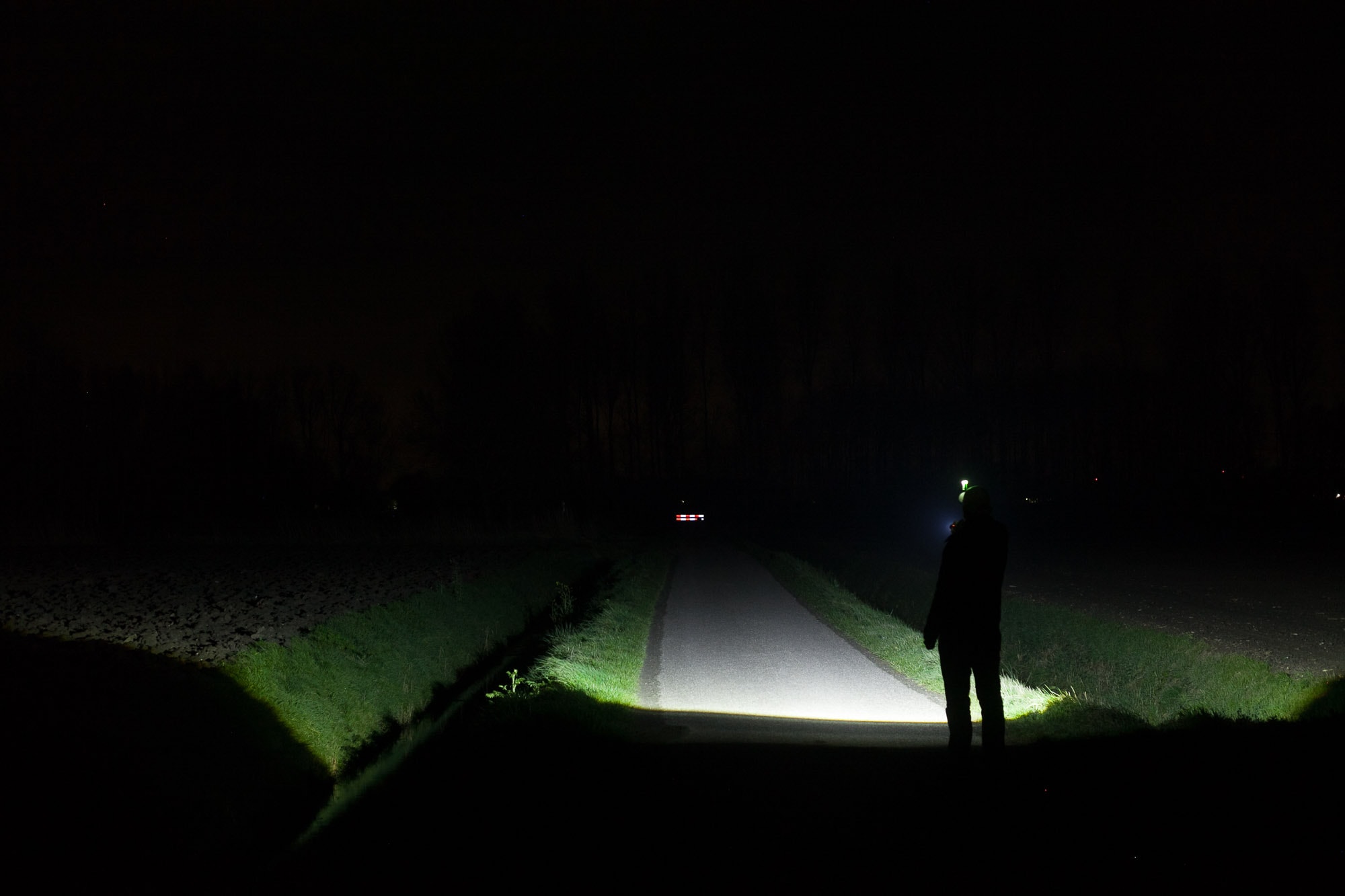
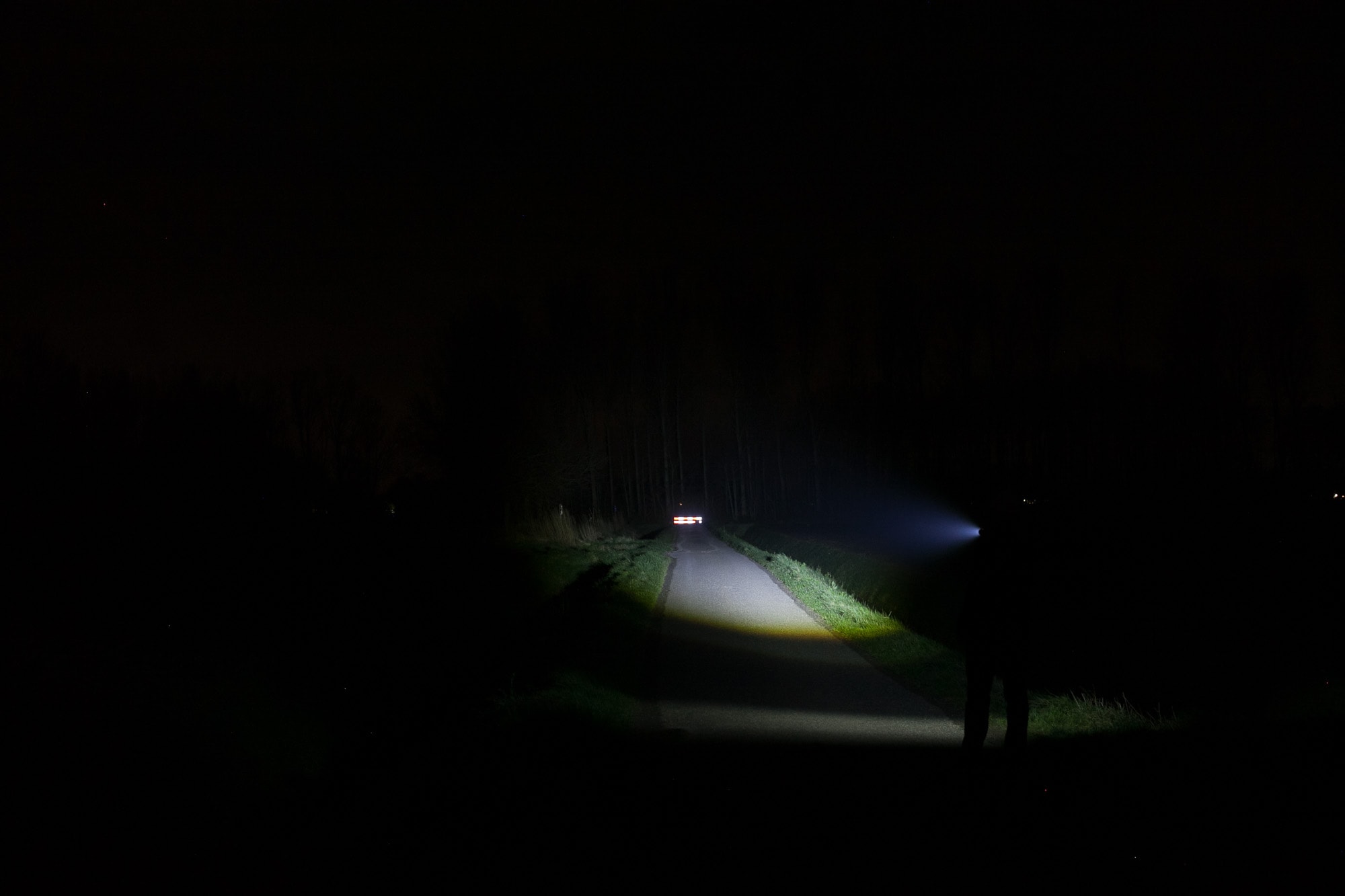
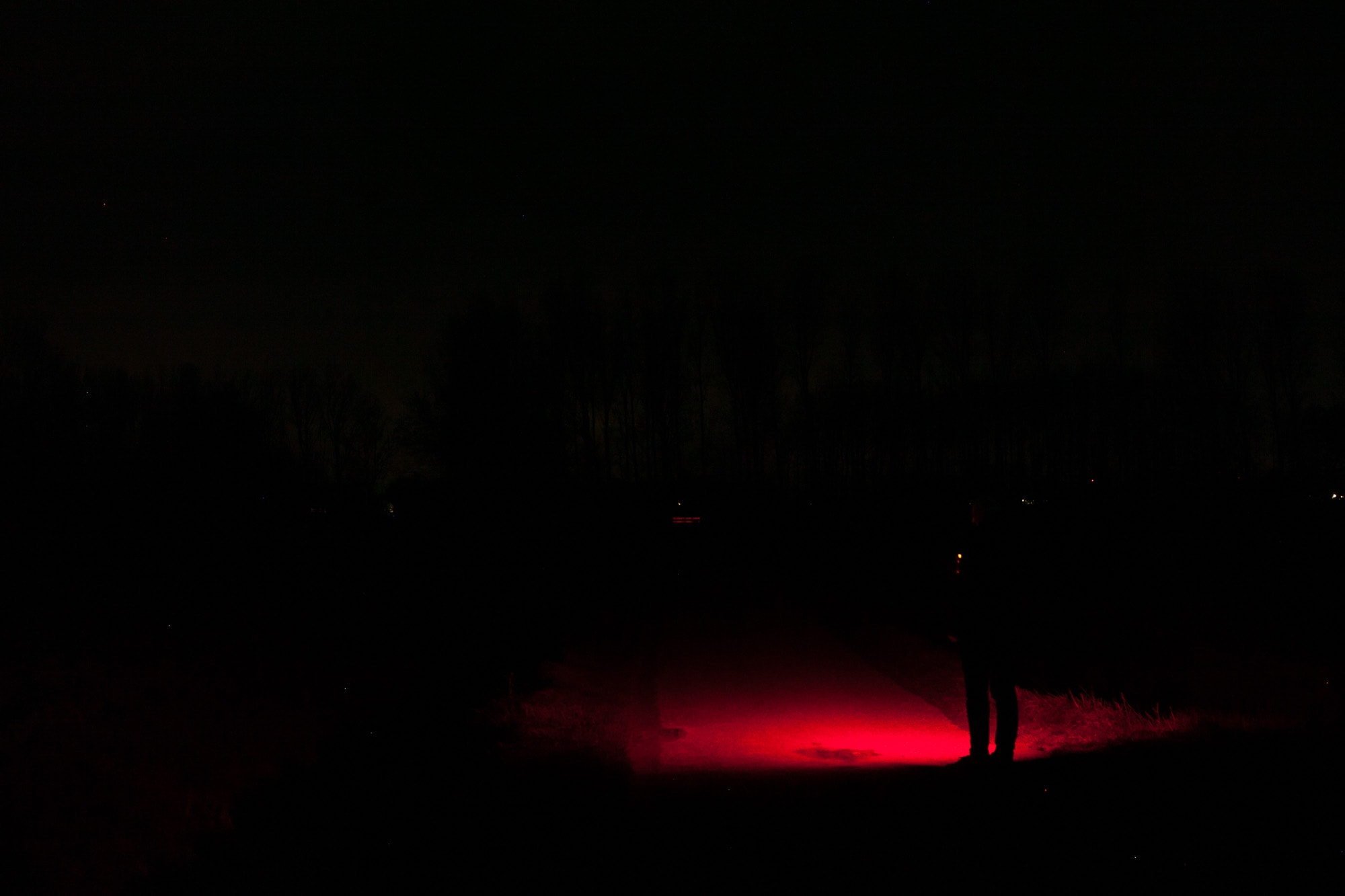
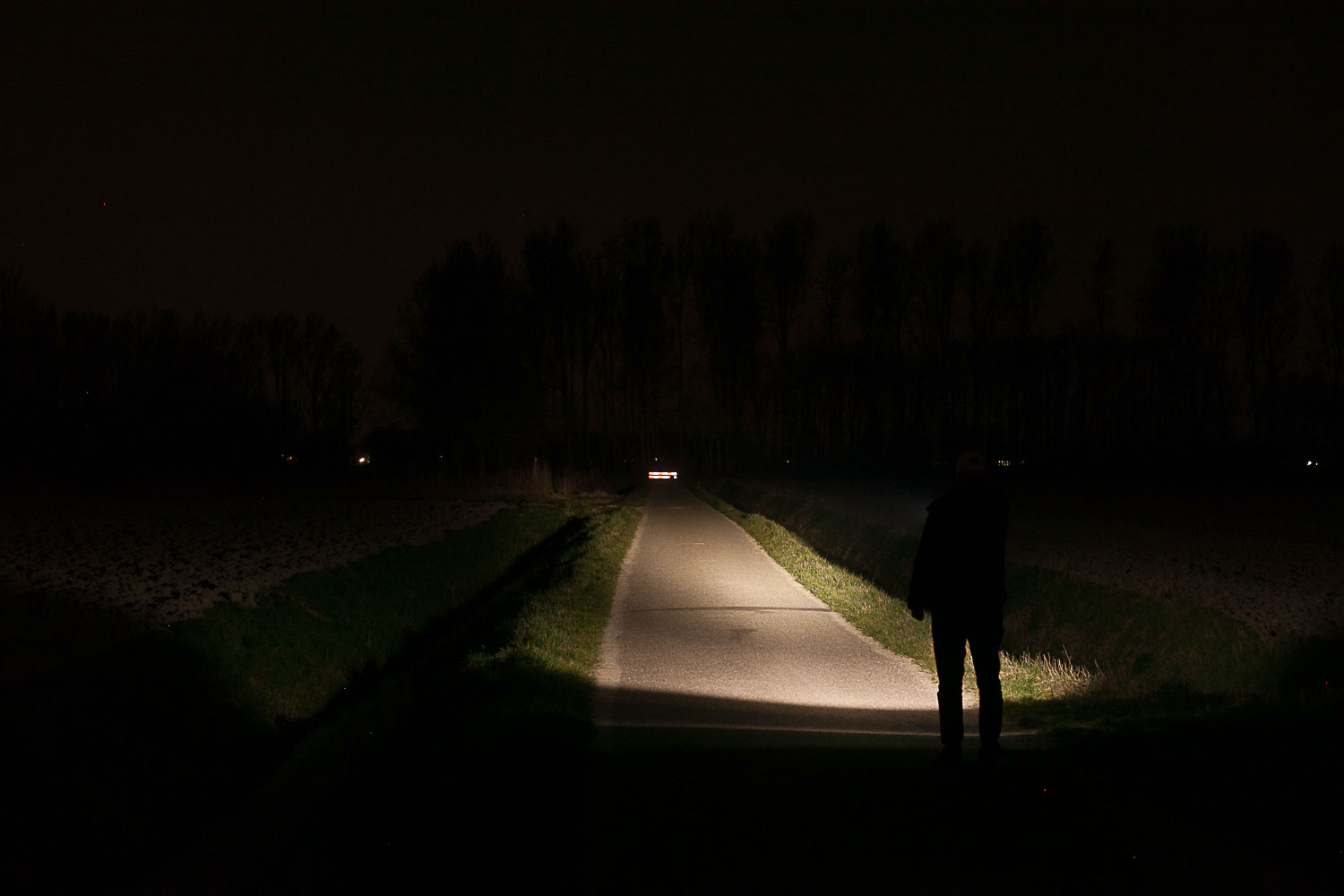
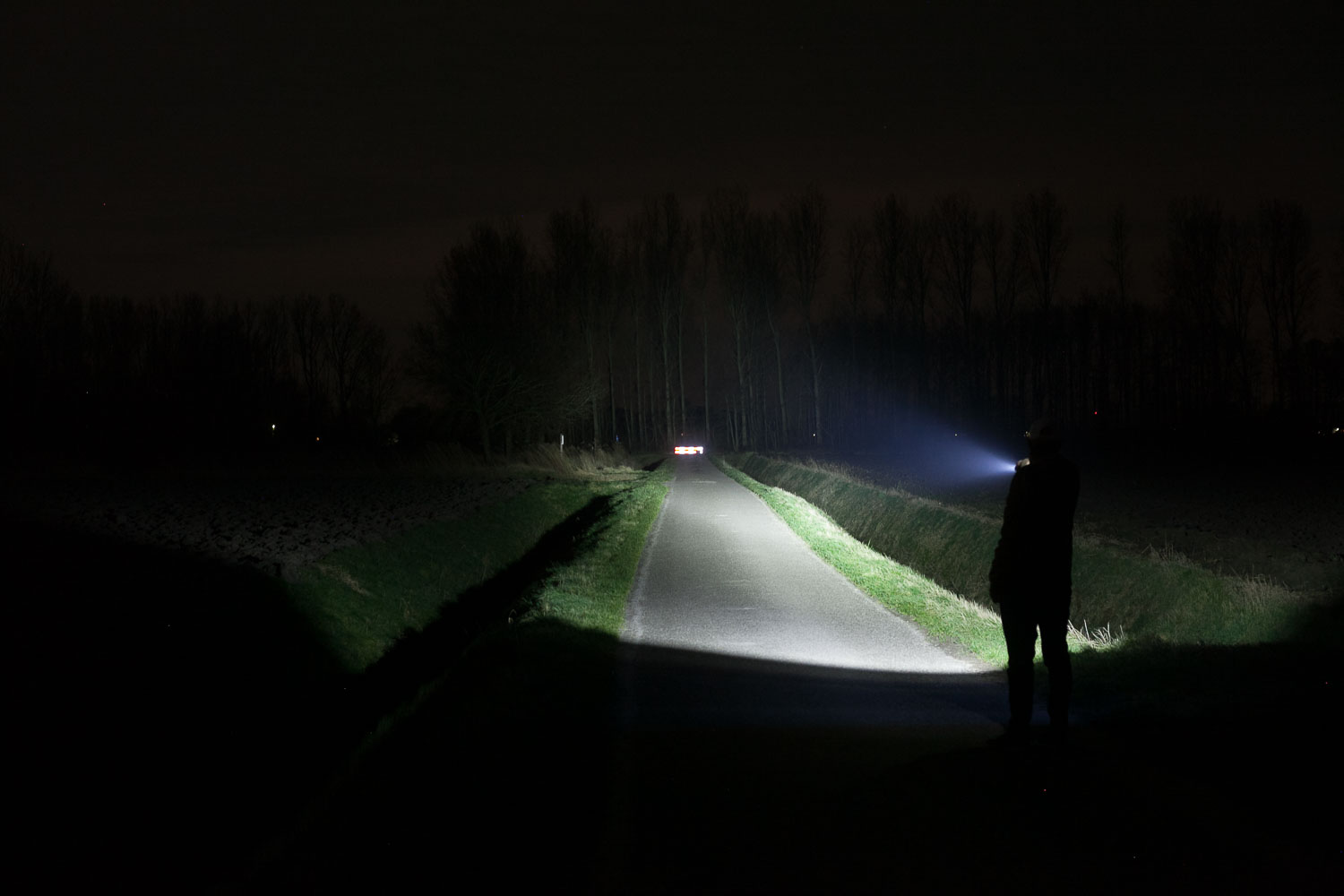
Disclaimer: This flashlight was sent to me for review at no cost by Nebo. I have not been paid to review, nor have I been holding back on problems or defects.
Final Verdict
Pros
- Nice size, and feel with the rubber sleeve
- Plenty bright for a work light
- Interesting dual light source design with hidden COB
- COB gives white and red light
- The built-in magnet is very strong
- The highest output doesn’t drop as quickly as most of its competitors. First 10 minutes it’s performing very well
Cons
- Visible PWM on lower output settings on both light sources
- Battery capacity is low at 2,200mAh
- Lowest output is not very low
- Very cold light (7000K+)
- Slow charging
- Battery level indicator has only 2 options: above 25% and below 25%. This is too vague, and should have more battery level indicators.
- Highest sustained output is low
Explanation on star ratings:
1: Avoid: my phone flashlight would be a better choice – 2: Poor: significant defect or issues; almost unusable – 3: Average: some defects or issues; but still usable 4: Good: recommended (minor issues) – 5: Great: highly recommended

3 stars: ★★★
I think the Pros and Cons written are a useful overview of what I found. It’s not recommended for flashlight enthusiasts, because of the visible PWM, low capacity proprietary battery. I do like the idea of the hidden COB and the extremely strong built-in magnet.
As a work light, it’s great in the highest output mode, but the PWM in the lower settings makes it unpleasant to use.
Nebo Slyde King 2K discount code, for sale:
Get 15% off your next Nebo purchase with our special 1Lumen discount code: 1lumen
1lumen selects and reviews products personally. We may earn affiliate commissions through our links, which help support our testing.